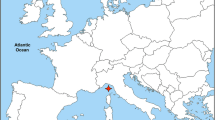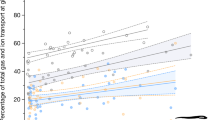Abstract
THREE principal surfaces are used for respiratory gas exchange in the anabantoid fish: (1) secondary lamellae of the gills; (2) plates of the labyrinthine organs lying dorsal to the gills; and (3) the respiratory membrane lining the suprabranchial cavity which contains the labyrinthine organs. Secondary gill lamellae are the sites of exchange between the blood and water, but the labyrinthine plates and respiratory membrane function during exchange between blood and the air contained within the suprabranchial chamber.
This is a preview of subscription content, access via your institution
Access options
Subscribe to this journal
Receive 51 print issues and online access
$199.00 per year
only $3.90 per issue
Buy this article
- Purchase on Springer Link
- Instant access to full article PDF
Prices may be subject to local taxes which are calculated during checkout
Similar content being viewed by others
References
Munshi, J. S. D., Proc. Linn. Soc., 179, 107 (1968).
Hughes, G. M., and Grimstone, A. V., Quart. J. Microsc. Sci., 106, 343 (1965).
Rauther, M., Ergb. Zool., 2, 517 (1910).
Henninger, G., Zool. Jb., 25, 251 (1907).
Author information
Authors and Affiliations
Rights and permissions
About this article
Cite this article
HUGHES, G., DATTA MUNSHI, J. Fine Structure of the Respiratory Surfaces of an Air-breathing Fish, the Climbing Perch Anabas testudineus (Bloch). Nature 219, 1382–1384 (1968). https://doi.org/10.1038/2191382a0
Received:
Issue Date:
DOI: https://doi.org/10.1038/2191382a0
This article is cited by
-
Functional morphology of air-breathing fishes: A review
Proceedings: Animal Sciences (1985)
Comments
By submitting a comment you agree to abide by our Terms and Community Guidelines. If you find something abusive or that does not comply with our terms or guidelines please flag it as inappropriate.



